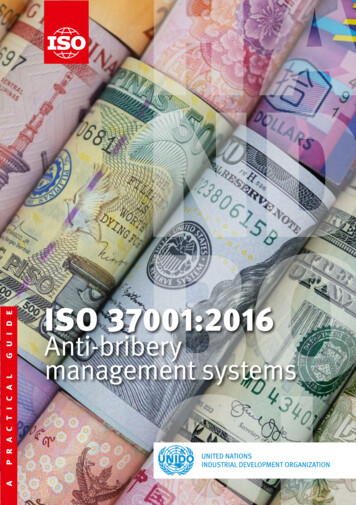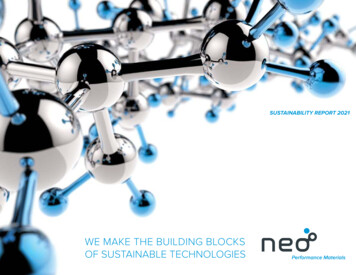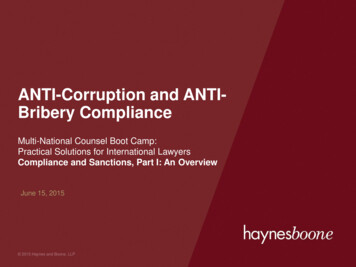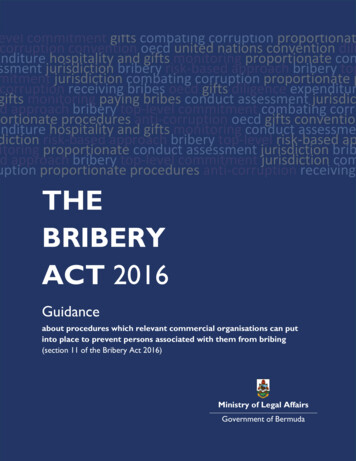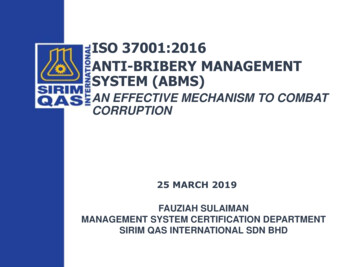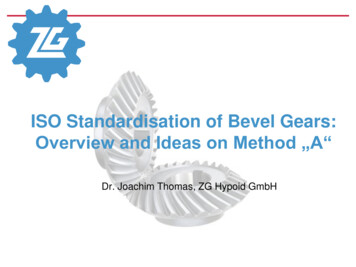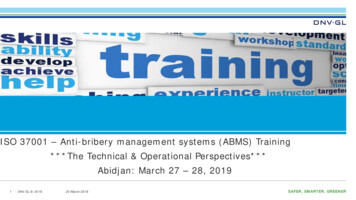
Transcription
ISO 37001 – Anti-bribery managementsystemsISO 37001 – Anti-bribery management systems (ABMS) Training***The Technical & Operational Perspectives***Abidjan: March 27 – 28, 20191DNV GL 201820 March 2018SAFER, SMARTER, GREENER
AgendaDay 2Day 109:00 – 10:00:10:00 – 11:00:11:30 – 12:30:14:00 – 15:00:15:15 – 16:15Intro and Course Objectives: ISOHLS and Key Concepts09:00 – 09:30 Review of Day 1 key conceptsBribery Challenges in the Region- TI CPI09:30 – 10:15 Leadership (Sec 5.) Roles/responsibilities, comp. functionand AB policy- Case Studies10:30 – 11:15 Planning (Sec. 6)ISO 37001 – Introduction and Scope(Sec. 1)11:15 – 12:15 Support (Sec. 7)Terms & Definitions (Sec. 3)Context of the Organization (Sec.4)13:30 – 14:15 Operations (Sec. 8) – Controls, duediligence, raising concerns andinvestigations14:15 – 15:00 Performance Evaluation (Sec. 9)15:15 – 16:00 Improvement (Sec. 10)16:00 – 16:30 Presentation of Certificates16:30 – 16:45 Closing remarks2DNV GL 201820 March 2018
INTRODUCTION & COURSE OBJECTIVES YESTERDAY – GENERAL OVERVIEW–ADVANTAGES & OPPORTUNITIES TODAY & TOMORROW – DETAIL–INCREASE GENERAL UNDERSTANDING–THE COMPONENTS OF ISO 37001–HOW THE STANDARD CAN BE USED–HOW I CAN USE THE STANDARD UNDERSTAND THE VALUE PROPOSITIONS3DNV GL 201820 March 2018
Purpose of the courseContext of the standardContent of the standardConformance with thestandard4DNV GL 201820 March 2018 Why establish an anti-bribery standard? The development, discussions and focus of the standard Reception and use of the standard Requirements and expectations Compliance and culture The importance of risk processes One size fits all? Reasonable and proportionate procedures? International recognition
Broken down into piecesContext: About ISO 37001High Level StructureBribery Risk AssessmentsManagement Leadership Planning Support Operation Performance Evaluation ImprovementQ&A5DNV GL 201820 March 2018
Introduction Name Role Experience Why are you here? Expectations6DNV GL 201820 March 2018
How can I contributeNew things will be fun, but also hard workFeel free to ask questions DNV GL 201820 March 2018Active contributions, pleaseShare experience, ideas and thoughts
Buzzing For Starters: What springs to mind when you hear «ISO 37001»?DNV GL 201820 March 2018
IMORTANT THEMES OF ISO 37001 STANDARD1) IT IS REAL (NOT A PAPER PROGRAM)WORDS AND ACTIONSRESOURCES3 YEAR STRUCTURE2) BASED ON COMMON SENSE ORGANIZATIONAL MANAGEMENT T & MONITORING/FACT-BASED & PRACTICAL3) SUSTAINABILITY & CHANGE – CONTINUAL IMPROVEMENT4) DOCUMENTATION – EVIDENCE, PROOF, ORGANIZATION, ACTIONS, INTENTIONS5) THE SYSTEM SHOULD CONFORM TO EXISTING ORGANIZATIONAL OPERATIONS“OPERATIONALIZATION”9DNV GL 201820 March 2018
ISO MANAGEMENT SYSTEMS HIGH LEVEL STRUCTURE & IMPORTANCE COMMON LANGUAGE– ISO 37001 (ANTI-BRIBERY MANAGEMENT SYSTEMS)– ISO 27001 (INFORMATION SECURITY MANAGEMENT SYSTEMS)– ISO 14001 (ENVIRONMENTAL MANAGEMENT SYSTEMS)– ISO 9001 (QUALITY MANAGEMENT SYSTEMS) LESS COST & COMPLEXITY EASIER TO: DO BUSINESS (COMMERCIALLY) E.G. MICROSOFT, WALMART, ALSTOM CONDUCT THE BUSINESS OF GOVERNMENT E.G. SINGAPORE, MALAYSIA, INDONESIA10DNV GL 201820 March 2018
High Level Structure - 10 Section structure1. ScopeBribery by or of organization, including its personnel and businessassociates – directly or indirectly – whether in public, private or nonprofit sectors2. NormativeReferenceSpecific to the discipline – “housekeeping”3. Terms &DefinitionsSpecific to the discipline – “housekeeping”4.1 Understanding the organization and its context4.2 Understanding the needs and expectations of interested parties4. Context of theOrganization4.3 Determining the scope of the Anti-bribery management system4.4 Anti-bribery Management system4.5 Bribery risk assessment5.1 Leadership and commitment5. Leadership5.2 Policy5.3 Roles, Responsibility & Authority.DNV GL 201820 March 2018
High Level Structure – 10 Section structure6. Planning7. Support8. Operation6.1 Actions to address risks and opportunities6.2 Anti-bribery objectives and planning to achievethem7.1 Resources7.5 Documented information7.2 Competence7.5.1 General7.3 Awareness7.5.2 Creating and updating7.4 Communication7.5.3 Control of documented information8.1 Operational Planning and Control9.1 Monitoring, measurement, analysis and evaluation9. PerformanceEvaluation10. Improvement9.2 Internal audit9.3 Management review10.1 Nonconformity and corrective action10.2 Continual ImprovementDNV GL 201820 March 2018
ISO 37001 –synergies for existing customers using ISO standards Common structure – All ISO management system standards in process of adopting a common framework “HighLevel Structure” Core set of requirements almost identical with other management standards Generic and relevant where at all possible Standard specific requirements – e.g. the need for a compliance function and the emphasis on whistleblowingthrough many chapters Annex is of special importance – provides guidance both for auditors and the company itself.13DNV GL 201820 March 2018
Bribery Challenges in the region: Africa Transparency International Corruption Perception Index (TI CPI) - 2018– Better: Botswana, Namibia, Ghana– Worse: Angola, Congo, Somalia– Cote d’Ivoire: 105/180 – score of 35/100 (but improvement: 27 points in 2013) Stanford University Law School (FCPA Clearinghouse Database)– http://fcpa.stanford.edu/fullsearch.html?q Ivory Coast– Search on “Ivory Coast” name: 6 matters– Examples – Map drill-down: 2 matters– Other country results . Perception outside of Africa is that Africa presents significant bribery challenges– Accurate?– Opportunities?14DNV GL 201820 March 2018
When (and where) red means stop?DNV GL 201820 March 2018www.vipe.no
An Anti-bribery management standard– why and how(ISO 37001 Introduction, Section 1 Scope andSection 3 Terms & definitions)16DNV GL 201820 March 2018
A visual summary of ISO 37001’s stepsReview andcontinuousimprovementAssess and checkimplementationTraining &awarenessGovernance &management systemStrategyRisk assessment Stakeholder mappingContextGap analysisWorkshopsRisk registerDNV GL 2018 Set target Decide priorities Budget20 March 2018 Policies andprocedures Implementation plans(controls) Roles andresponsibilities Training program Roll out andimplementation Effect Managementreporting Audits (Whistle blowing) Regular managementreview Result vs. target Realign and improve Apply lessons learned
The Certification ProcessGAP Analysis High Level CB orconsultants Helps mapimplementationTrainingStage 1 audit Various levelsin organization Overview,Internal AuditorStage 2 auditImplementationDNV GL 201820 March 2018 Testing theeffectiveness of thesystem “Do you do what yousay you do?”Surveillances Standalone orusingconsultantsPre-Assessment18 Focused ondocumentation “Show us whatyou do”audits A “mock” audit Takes away fearof audit Yearly audits Less mandays 50% ofprocessesRecertificationaudits 100% ofprocesses More days thansurveillance,less than stage1 2
How is audit time calculated?Country RiskTransactional Risk Lack of enforcement of antibribery legislation; The need to use wellconnected intermediaries togain access to people inpositions of power; andmore. Dealings with government Obtaining licenses, permitsand regulatory clearances ofany kind Charitable and politicaldonations, etcA Risk BasedApproachBusiness OpportunityRisk Complexity (number ofparties involved, use ofconsortia, etc) Complex commercialtransactions – routing, prices19DNV GL 201820 March 2018Sectoral Risk High degree of interactionwith government; Business activities involvingmultiple business partners,stakeholders and/or complexcontractual or corporatestructuresOnce risk is applied, other variablesinclude:– Number of locations– Number of employees IN SCOPE– Interactions between head office andother locations– Activities performed in locations
Some examples:– Software company; operations in EasternEuropean Country.– Construction company; operations inMalaysia.– Locations in scope: USA, Romania– Locations in scope: USA, 2 in Malaysia(engineering and sales/licensing)– Employees in scope: 50 in each location– Previous allegation of corruption in EasternEurope.– Sales to government, transactions includingvarious countries; use of agents to sell.20– Employees in scope: 5 (US), 200(Engineering), 5 (Sales/Licensing)– Large, complex, construction projects,mainly to government.– Initial audit: 7 (3) days in USA; 9 (5) days inRomania– Initial audit: 5.5 (2.5) days in USA; 6 (3)days in Engineering; 7.5 days in Sales– Surveillance audit: 4 days– Surveillance audit: 7 days– Re-certification audit: 6 days– Re-certification audit: 11 daysIn parenthesis: tech expert daysIn parenthesis: tech expert daysDNV GL 201820 March 2018
That was then, this is now – increasing expectationsForeignCorruptPracticesActConvention on Combatting Council of EuropeBribery of Foreign Public Criminal and CivilOfficial in International Law Convention onTransactionsCorruption1977DNV GL 201820 March Penal CodeUKBribery Act200320032011Italy – law 190 & 69Brazil – Clean Company ActFrance – 2016China – Continuous.2011 -
FRANCE – RECENT AB LAW CHANGES – “SAPIN II” Effective 2017 and focusing on: public officials who solicit or accept a bribe and privateindividuals who try to corrupt a public official For companies (over 100 M Euros in turnover and 500 employees) an anti-corruption programrequirement:– Adopt a code of conduct - give clear and practical guidance tools to employees;– Set up a whistleblowing system– Create a risk map, ranking and classifying the company’s risks of exposure to corruption– Run due diligence on the company’s major clients, suppliers and intermediaries;– Implement internal or external accounting auditing processes to make sure that accountingbooks are not used to conceal corruption or influence peddling acts;– Train the employees that are more at risk;– Set up a disciplinary process that enables punishment for employees that breach the code ofconduct; and– Set up an internal process to control and evaluate the measures implemented22DNV GL 201820 March 2018
Situation prior to ISO 37001: What is an “effective compliance program”? (US)and What are “adequate procedures”? (UK) Increased (and increasingly costly) Foreign Corrupt Practices Act(FCPA) investigations and settlements in US Other countries’ enactments of anti-bribery legislation – followingenforcement examples of US, UK and Germany More individual liability risk for corporate executives (not justwriting a check for a company settlement using shareholders’ ) More complex and costly anti-bribery legal complianceenvironment Business solution: Global anti-corruption certification based onaccredited independent 3rd party audit of an anti-briberymanagement system.DNV GL 201820 March 201823
THE DIFFERENCES: TESTING, TIMING & POSITIONING EXISTING FCPA AND OTHER LEGAL STANDARD ANTI-CORRUPTION PROGRAM(S) NO CERTAINTY AS TO WHETHER OR NOT PROGRAM IS “EFFECTIVE” UNTIL BACK-ENDTESTED IN WORST-CASE DOJ/SEC INVESTIGATION SCENARIO A LEGAL STANDARD ISO 37001 ANTI-BRIBERY MANAGEMENT SYSTEM CERTIFICATION TANGIBLE AND POSITIVE FRONT-END TESTED GLOBAL STANDARD - W/ ASSOCIATEDBUSINESS BENEFITS PROCEDURALLY, ISO 37001 SYSTEMS APPROACH ALIGNS WITH DOJ EMPHASIS ON“OPERATIONALIZING COMPLIANCE” – PLACING CONTROLS WHERE RISK EXISTS EMPHASIZES “HERE’S WHAT IT IS” AND “HERE’S HOW TO DO IT” INSTEAD OF “THOUSHALT NOT” A BUSINESS STANDARD – APPLICABLE TO ORGANIZATIONS OF ALL KINDS24DNV GL 201820 March 2018
BUSINESS BENEFITS I OPERATIONALLY – LEVERAGE EXISTING FCPA AND ANTI-CORRUPTION COMPLIANCE PROGRAMACTIVITIES FOR MOST COMPANIES W/ AN ACTIVE, SERIOUS PROGRAM – 75% OR MORE OF ISO 37001REQUIREMENTS LIKELY SUBSTANTIALLY COMPLETED CORPORATE BUSINESS EXECS WANT COMPLIANCE TO BE MORE BUSINESS-LIKE! PROVIDES OPPORTUNITIES TO “REFRESH” A MATURE PROGRAM FINANCIALLY – REDUCE OR OFFSET ANTI-BRIBERY COMPLIANCE COSTS “SPEAKING” ISO 37001 COMMON ANTI-BRIBERY LANGUAGE ELIMINATES “ONE-OFFS” AND“BATTLE OF FORMS” DRIVE ISO 37001 CERTIFICATION THROUGH PRIMARY SUPPLY CHAIN PARTICIPANTS 9001 REVENUE GENERATION CASE STUDIES25DNV GL 201820 March 2018
BUSINESS BENEFITS II STRATEGICALLY – BUILD STAKEHOLDER CONFIDENCE AND TAKE THE REPUTATIONAL “HIGHGROUND” PARTICULAR VALUE FOR COMPANIES: (A) SEEKING POSITIVE DIFFERENTIATION;(B) UNDER INVESTIGATION OR MONITORSHIP; (C) IN SECTORS WHERE COMPETITORS AREUNDER INVESTIGATION; (D) IN OTHER HIGH-BRIBERY-RISK SECTORS OR GEOGRAPHIES;OR (E)WHERE BRIBERY ALLEGATIONS OR ISSUES MAY HAVE EXISTED IN PAST FORCOMPANY BUSINESS BENEFIT CRITICAL SUMMARY POINTS: AN ISO 37001 SYSTEM SUPPORTS BUT IS NOT A SUBSTITUTE FOR AN ANTI-BRIBERYPROGRAM THAT MEETS AN ORGANIZATION’S LEGAL REQUIREMENTS IT IS UNLIKELY THAT LAW ENFORCEMENT AUTHORITIES WILL “BLESS” ISO 37001 ANY TIMESOON MARKET NEED: FRONT-END CERTIFICATION BASED ON A COMMON ANTI-BRIBERY LANGUAGE26DNV GL 201820 March 2018
GOVERNMENT BENEFITS – ISO 37001 ADOPTION TO BENEFIT ALL CITIZENS– Bribery is wasteful, creates market inefficiencies, weakens the rule of law anddisproportionately hurts the poor– ISO 37001helps address these social, economic and legal issues TO CHANGE PERCEPTIONS – INTERNALLY & EXTERNALLY– Civil society– Potential investors– Lenders/donors TO PROJECT POWER Making stakeholders look forward, not to the past, through serious anti-bribery statement Not 105/180 on TI CPI, but a leader in applying ISO 3700127DNV GL 201820 March 2018
TRANSITION: FROM THE CONCEPTUAL TO THE SUBSTANCEDNV GL 20182820 March 2018
The essential test for any anti-corruptionprogram [or system] is whether it is welldesigned for the risks facing the company, andwhether it is rigorously applied to prevent anddetect bribery.Transparency International29DNV GL 201820 March 2018
Anti-bribery - context & trends(including sections 1-3)30DNV GL 201820 March 2018
What is «bribery»? “.offering, promising, giving, accepting or soliciting of an undue advantage of anyvalue (which could be financial or non-financial), directly or indirectly, andirrespective of location(s), in violation of applicable law, as an inducement orreward for a person acting or refraining from acting in relation to the performance(3.16) of that person’s duties” Anything the receiver (commercial or governmental) may or reasonably couldhave an interest in:– Travels, dinners, stock-options, memberships, promises, recognition, etc. Occurs in different forms and shapes: Obvious money bribes and kickback Gifts, hospitality and entertainment Agents and intermediaries Facilitation payments or extortion Political donations Favourism (nepotism, conflict of interest)31DNV GL 2018Corporate Responsibility 20 March 2018
Bribery – easy does it32DNV GL 201820 March 2018
Trading in influence33DNV GL 201820 March 2018
Now, how about this? Your are up against stiff competition in trying to establish yourself as a preferred candidate to aparticular attractive governmental contract. The decision makers have not said anything, butrumors have it that you are about to drop out of the top of the short list. You carefully checkthrough your network, and this actually seems to be correct. One of your advisors, a communications and public relations firm, suggests that they approachsome of the participants of the project group – whom they all know from their previous jobs invarious governmental institutions - and express the idea that your company could be is willing to"show local social responsibility and philanthropic efforts“ as part of the deal. This has been done previously, sometimes with good results though there can be no guarantee.Should you give it a try?34DNV GL 201820 March 2018
Special status: Facilitation payment May be legal or treated as less serious several places (i.e. the FCPA). Facilitation payment is the term sometimes given to an illegal orunofficial payment made in return for services which the payer islegally entitled to receive without making such payment. It is normallya relatively minor payment made to a public official or person with acertifying function in order to secure or expedite the performance of aroutine or necessary action, such as the issuing of a visa, workpermit, customs clearance or installation of a telephone. Althoughfacilitation payments are often regarded as different in nature to, forexample, a bribe paid to win business, they are illegal in mostlocations, and are treated as bribes for the purpose of this document,and therefore should be prohibited by the organization’s anti-briberymanagement system.– A.2.2.135DNV GL 201820 March 2018
Facilitation payments continued Dear Susy,One of the drivers at our subcontracted company Speedy Wheels has reported that our consignment offresh salmon destined for Latvia got stuck at customs in Riga. Apparently the port was exceptionallybusy he had to pay a special fee to the port officials to make sure that the consignment could pass safelywithout delay, which might otherwise have caused damage to the shipment.Since most of our subcontractors only use casually employed drivers who do not have much cash athand to cover for such unforeseen costs, we should make a reimbursement as soon as possible. I am notfully sure how to account for this type of payment, which in itself is not much, roughly 80 Euros. We donot have a receipt for this port fee, so I need your advice on how to administer it for the record (andhow to manage such situations should they occur again in future).Thanks!Bob36DNV GL 201820 March 2018
Preliminary considerations: ISO 37001 - INTRODUCTION Bribery is widespread, and increases costs to all parts of society (except for those few individuals/entitiesinvolved in the actual transactions) in developed and lesser-developed worlds It is (in most jurisdictions) an offense for individuals to engage in bribery– Organizations and individuals held accountable. Businesses and business stakeholders in the US and elsewhere are coming to appreciate the Europeanpoint of view: organizations have a responsibility to proactively contribute to combating bribery– Anti-bribery management system (ABMS) approach is timely and well-suited to this thinking– Particularly important elements:– Leadership commitment to establish a culture of integrity, transparency, openness and compliance– Culture critical to the success (or failure) of the ABMS– Scoping – risk-based, reasonable & proportionate The standard reflects international leading practices - can be used in all jurisdictions, by organizations ofall types and sizes Helps implement measures designed to prevent, detect and respond to bribery (but it’s a pervasive andpersistent problem)37DNV GL 201820 March 2018
ISO 37001 basics: ISO 37001 Introduction and Section 1. Scope ISO 37001 is an anti-bribery management systems (ABMS) standard, published in October 2016 Designed to help an organization establish, implement, maintain and improve an anti-briberycompliance system – supporting the organization’s anti-bribery (legal) program Includes required measures which an organization must implement, and other recommendations– Note language distinctions: shall, vs. should vs. may vs. can Accompanied by supporting guidance: Annex A ISO 37001 requirements are designed to be integrated into the organization’s existing managementprocesses and controls To meet ISO 37001 requirements, an organization must address:– Bribery by the organization, or by its personnel or business associates acting on the organization’sbehalf or for its benefit– Bribery of the organization, or of its personnel or business associates in relation to theorganization’s activities– Commercial bribery or bribery involving governmental officials (different than the FCPA) Bribery is defined by law which varies between countries, the standard therefore provides onlyguidance on what is meant by bribery to help users understand the intention and scope of thestandard.38DNV GL 201820 March 2018
Need-to-know Terms & Definitions3.1 – BriberyOffering, promising, giving, accepting or soliciting of an undue advantage of any value (whichcould be financial or non-financial), directly or indirectly, and irrespective of location(s), inviolation of applicable law, as an inducement or reward for a person acting or refraining fromacting in relation to the performance of that person's duties3.6/3.7 – Top Management and Governing BodyPerson or group of people who directs and controls an organization at the highest level.Group or body that has the ultimate responsibility and authority for an organization's activities,governance and policies and to which top management reports and by which top management isheld accountable.3.8 – Anti-bribery Compliance FunctionPerson(s) with responsibility and authority for the operation of the anti-bribery managementsystem.39DNV GL 201820 March 2018
Need-to-know Terms & Definitions II3.26 – Business AssociateExternal party with whom the organization (3.2) has, or plans to establish, some form of businessrelationship. [see “Annex” for details – key concept in the standard]3.27 – Public OfficialPerson holding a legislative, administrative or judicial office, whether by appointment, election orsuccession, or any person exercising a public function, including for a public agency or publicenterprise, or any official or agent of a public domestic or international organization, or anycandidate for public office.3.30 – Due DiligenceProcess to further assess the nature and extent of the bribery risk and help organizations makedecisions in relation to specific transactions, projects, activities, business associates and personnel.40DNV GL 201820 March 2018
37001 – Requirements SummaryThe organization must implement a series of measures and controls in arisk-based, reasonable and proportionate manner to help prevent,detect, and deal with bribery, including: Implement Anti-bribery policy and overall management system Communicate the policy and system to all relevant personnel andbusiness associates (joint venture partners, sub-contractors, suppliers,consultants etc.) Appoint compliance manager (full time or part time) to oversee systemactivities Provide appropriate anti-bribery training to personnel Assess bribery risks, including appropriate due diligence Take risk-based, reasonable and proportionate steps to ensure thatcontrolled organisations and business associates have implementedappropriate anti-bribery controls41DNV GL 201820 March 2018
37001 – Requirements Summary, part II Verify as far as reasonable that personnel will comply with the antibribery policy. Control gifts, hospitality, donations and similar benefits to ensure thatthey do not have a corrupt purpose. Implement appropriate financial, procurement and other commercialcontrols so as to help prevent the risk of bribery.- Due diligence on projects and business associates Implement reporting (whistle-blowing) procedures. Investigate and deal appropriately with any actual or suspectedbribery. Show (top management) leadership, commitment and responsibility Establish system for corrective action and continual improvement If the whole or part of a requirement is prohibited by applicable law(e.g. if anonymous reporting is prohibited), then an organization willnot be required to comply with that prohibited part, but can complywith the remainder of the standard.42DNV GL 201820 March 2018
A visual summary of ISO 37001’s stepsReview andcontinuousimprovementAssess and checkimplementationTraining &awarenessGovernance &management systemStrategyRisk assessment Stakeholder mappingContextGap analysisWorkshopsRisk registerDNV GL 2018 Set target Decide priorities Budget20 March 2018 Policies andprocedures Implementation plans(controls) Roles andresponsibilities Training program Roll out andimplementation Effect Managementreporting Audits (Whistle blowing) Regular managementreview Result vs. target Realign and improve Apply lessons learned
Section 4 Context- context, stakeholders and risk44DNV GL 201820 March 2018
Context and sustainability - crucial for scope“ The organization shall determine external andinternal issues that are relevant to its purpose andthat affect its ability to achieve the objectives of itsanti-bribery management system» (4.1)“. . . determinea) The stakeholders that are relevant to the anti-briberymanagement system;b) The relevant requirements of these stakeholders.» (4.2)“. . .consider issues referred to in 4.1, therequirements referred to in 4.2, the risks identifiedin 4.5, and opportunities for improvement» (6.1)45DNV GL 201820 March 2018
4. Context of the organization 4.1 – Understanding context– Who, what, where, with whom & how do you operate? Must be documented, per 4.5.4. 4.2 – Stakeholders– Identify, confirm, avoid expectation gaps 4.3 – Scope of the ABMS (proportionate to risk)– Based on results from 4.1, 4.2 and 4.5, boundaries of ABMS must be documented. 4.4 – Anti-bribery management system– Establish, document, implement, maintain, continually review – improve when/where necessary.– See A.3 for guidance. 4.5 – Bribery risk assessment– Regular (and/or in event of significant changes), clear criteria for evaluating level of bribery risk (consequence and probability).Must be documented.– See A.4 for guidance.46DNV GL 201820 March 2018
ISO 37001: Context & stakeholders especially important?Public opinionGeography Culture, local rules, degree ofimplementation Local versus global expectations?Partners Who are helping us?Who are we working with?Who are our customers?Who are our suppliers?“The law” 47DNV GL 201820 March 2018National lawOther laws/regulations?
Stakeholders Baseline (Commercial) EmployeesInvestors/LendersCustomers Suppliers Partners Local society Competitors/SectorDNV GL 201820 March 201848 Political environment Unions NGO & Advocacy groups Media Opinion leaders Academia International organizations
49DNV GL 201820 March 2018
BE PROACTIVE: Have System in place prior to things happening, as they will.DNV GL 201820 March 201850
4.5 - Bribery risk assessment 4.5.1 The organization shall undertake regular bribery risk assessment(s) which shall:– a) identify the bribery risks the organization might reasonably anticipate, given the factors listed in 4.1– b) analyse, assess and prioritize the identified bribery risks– c) evaluate the suitability and effectiveness of the organization's existing controls to mitigate the assessed bribery risks 4.5.2 The organisation shall establish criteria for evaluating its level of bribery risk, which shall take into account theorganization's policies and objectives 4.5.3 The bribery risk assessment shall be reviewed:– a) on a regular basis so that changes and new information can be properly assessed based on timing and frequency definedby the organization– b) in the event of a significant change to the structure or activities of the organization 4.5.4 The organization shall retain documented information that demonstrates that the bribery risk assessment has beenconducted and used to design or improve the anti-bribery management system See A.4 for guidance51DNV GL 201820 March 2018
Necessary to consider risks at different levels?Country levelSector levelCountries where we operateshould be evaluated.Will vary, but there shouldbe proof of process andunderstanding of own andother relevant sector levelof corruption risk.Countries where our(important) businesspartners operate should beevaluated.52DNV GL 201820 March 2018Certain processes,selectedpositions,transactionsJV and partnershipsInteraction with publicofficials (licenses etc.)Procurement, sales, Csuite, compliance, etc.
2Other dealings with government (or privatesector)567853DNV GL 2018Use of suppliers / contractorsFacilitation paymentsCR / CSRGifts, entertainment, travel20 March 2018LikelihoodUse of intermediaries (agents)5 43 27 86Low4M&A and JVVery low31HighGovernment (or commercial) contractsMedium1Very highProvide an accurate description of inherent risk picture?Very lowLowMediumConsequenceHighVery highOverall conclusion: Medium-high risk level (TI score confirms this) Grand corruption – links between big business and politicalelites risk
. . . followed by actual/residual risksVery high1 Use of suppliers / contractors19Medium3 Other dealings with governmentLikelihoodHigh2 Use of intermediaries264 CR / CSR6 M&A and JV7 Gifts, entertainment, travel8 Facilitation payments9 Reporting10 Training54DNV GL 201820 March 2018Low7 58Very low5 Government contracts3 4 10Very lowLowMediumConsequenceHighOverall conclusion: Low-medium residual risk Strong internal culture and high level of awareness Some key gaps identified that need to be addressedVery high
Risk-based approach revisited What does the standard mean by «risk based approach»? Part of HLS and generic, but is it particularly important for this anti-briberystandard? The risk assessment is the organization’s opportunity to: Ensure that the anti-bribery management system fits the organization «risk-based, reasonable and proportionate»55DNV GL 201820 March 2018
Risk exercise: Assessing risk, identifying red flags Fact pattern: Conducting governmental affairs in West Africa Work in groups of minimum 2 persons each, identify possible risks involved Learning objectives:– To understand what are the different types of risks and red flags, and how to assess theseverity and potential impact of different risks.– Begin to see how internal processes should be aligned to identify and handle these red f
- leverage existing fcpa and anti -corruption compliance program activities for most companies w/ an active, serious program - 75% or more of iso 37001 requirements likely substantially completed corporate business execs want compliance to be more business-like! provides opportunities to "refresh" a mature program financially
